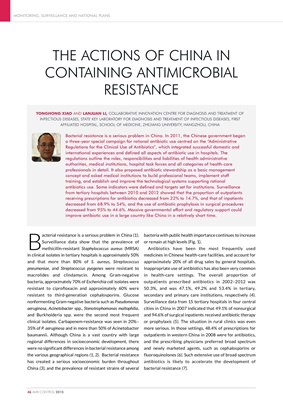
MONITORING, SURVEILLANCE AND NATIONAL PLANS
46 AMR CONTROL 2015
B
acterial resistance is a serious problem in China (1).
Surveillance data show that the prevalence of
methicillin-resistant Staphylococcus aureus (MRSA)
in clinical isolates in tertiary hospitals is approximately 50%
and that more than 80% of S. aureus, Streptococcus
pneumoniae, and Streptococcus pyogenes were resistant to
macrolides and clindamycin. Among Gram-negative
bacteria, approximately 70% of Escherichia coli isolates were
resistant to ciprofloxacin and approximately 60% were
resistant to third-generation cephalosporins. Glucose
nonfermenting Gram-negative bacteria such as Pseudomonas
aeruginosa, Acinetobacter spp., Stenotrophomonas maltophilia,
and Burkholderia spp. were the second most frequent
clinical isolates. Carbapenem-resistance was seen in 20%-
35% of P. aeruginosa and in more than 50% of Acinetobacter
baumannii. Although China is a vast country with large
regional differences in socioeconomic development, there
were no significant differences in bacterial resistance among
the various geographical regions (1, 2). Bacterial resistance
has created a serious socioeconomic burden throughout
China (3), and the prevalence of resistant strains of several
bacteria with public health importance continues to increase
or remain at high levels (Fig. 1).
Antibiotics have been the most frequently used
medicines in Chinese health-care facilities, and account for
approximately 20% of all drug sales by general hospitals.
Inappropriate use of antibiotics has also been very common
in health-care settings. The overall proportion of
outpatients prescribed antibiotics in 2002-2012 was
50.3%, and was 47.1%, 49.2% and 53.4% in tertiary,
secondary and primary care institutions, respectively (4).
Surveillance data from 15 tertiary hospitals in four central
cities in China in 2007 indicated that 49.1% of nonsurgical
and 94.6% of surgical inpatients received antibiotic therapy
or prophylaxis (5). The situation in rural clinics was even
more serious. In those settings, 48.4% of prescriptions for
outpatients in western China in 2008 were for antibiotics,
and the prescribing physicians preferred broad spectrum
and newly marketed agents, such as cephalosporins or
fluoroquinolones (6). Such extensive use of broad spectrum
antibiotics is likely to accelerate the development of
bacterial resistance (7).
THE ACTIONS OF CHINA IN
CONTAINING ANTIMICROBIAL
RESISTANCE
YONGHONG XIAO AND LANJUAN LI, COLLABORATIVE INNOVATION CENTRE FOR DIAGNOSIS AND TREATMENT OF
INFECTIOUS DISEASES, STATE KEY LABORATORY FOR DIAGNOSIS AND TREATMENT OF INFECTIOUS DISEASES, FIRST
AFFILIATED HOSPITAL, SCHOOL OF MEDICINE, ZHEJIANG UNIVERSITY, HANGZHOU, CHINA
Bacterial resistance is a serious problem in China. In 2011, the Chinese government began
a three-year special campaign for rational antibiotic use centred on the "Administrative
Regulations for the Clinical Use of Antibiotics", which integrated successful domestic and
international experiences and defined all aspects of antibiotic use in hospitals. The
regulations outline the roles, responsibilities and liabilities of health administrative
authorities, medical institutions, hospital task forces and all categories of health-care
professionals in detail. It also proposed antibiotic stewardship as a basic management
concept and asked medical institutions to build professional teams, implement staff
training, and establish and improve the technological systems supporting rational
antibiotics use. Some indicators were defined and targets set for institutions. Surveillance
from tertiary hospitals between 2010 and 2012 showed that the proportion of outpatients
receiving prescriptions for antibiotics decreased from 22% to 14.7%, and that of inpatients
decreased from 68.9% to 54%, and the use of antibiotic prophylaxis in surgical procedures
decreased from 95% to 44.6%. Massive governmental effort and regulatory support could
improve antibiotic use in a large country like China in a relatively short time.